To make a a 1660s gown for the celebrated 17th c French beauty, arts patron, and sometimes nun, sometimes courtesan, Ninon de l’Enclos. And it had to be out of golden yellow duchesse silk satin.
As there are no images of Ninon that were made in her own life, my design is based on a 1670s portrait of Élisabeth d’Orleans, with further inspiration from Bartholomeus van der Helst’s 1660-61 portrait of a couple, the 1660’s Bath dress, and a 1660’s bodice (in yellow duchess satin!) from a German collection.
In order to really experience the work of a 17th century seamstress, the ensemble is entirely handsewn except for the boning channels on the bodice support (sorry, done that once, never doing it again). As much as possible I have researched and used 17th century stitches and garment construction.
Inspiration Gallery
 |
 |
 |
| Élisabeth d’Orleans, Beaubrun, 1670 | Couple, 1660-61, van der Helst | Bodice, probably German, 1660s |
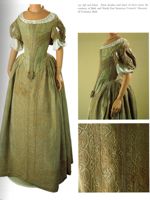 |
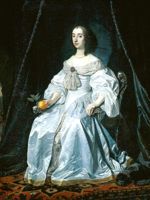 |
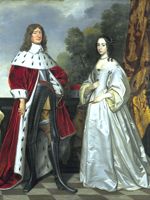 |
| Dress, 1660s, Museum of Fashion | Mary, 1652, van der Helst | Fredrick & Louise, van Honhurst, 1650 |
Fabric and Materials:
- Custom dyed yellow duchesse silk satin over a bodice of unbleached linen boned in cable ties.
- Skirt of custom dyed yellow duchesse silk satin
- Cotton & silk thread to sew
The Undergarments:
- A 17th c shift, quilted petticoats, and possibly a bumroll
The Dress Diary:
- Introducing the idea: A dress for Ninon
- Dyeing the fabric: Angels sing
- The skirt
- Drafting & fitting the bodice pattern
- The boning layout
- Re-doing the bodice point
- Covering the bodice
- The back fastenings
- A 17th c shift
- A quilted petticoat
- A try on: be in love
- The bodice lining & eyelets
- Binding the tabs
- The sleeves
- Accessories for the dress
- A sneak-peak in the dressing room at the Grandeur & Frivolity talk
- Another sneak-peak
- The finished dress at Grandeur & Frivolity
- Baroque & Rococo out-takes I
- Baroque & Rococo out-takes II
- The finished dress at Premier House
- The finished dress at Premier House II
- Pretty princesses in yellow
- Walk with me at the old Dominion Museum
- Balconies, Staircases & Ballrooms photoshoot
- Let there be Light photoshoot
- Ninon at a talk at the Museum of Wellington City & Sea
- The fully trimmed Ninon gown
Research and helpful links:
- Detailed images of the construction of the Bath dress
- Research on 17th century fashion (including a pattern for the 1660s yellow bodice, above). (in German)
- Kendra of Demode’s Dress Diary for her 1668 Nell Gwynn gown
- How to make a 17th c petticoat on Marquise.de
- Research on, and images of, as well as a pattern for 17th c shifts at Isis’ Wardrobe
- North, Susan and Jenny Tiramani (ed.) Seventeenth-century Women’s Dress Patterns, London: V & A Publishing. 2010.
- Hart, Averil and North, Susan. 17th and 18th Century Fashion in Detail, London: V & A Publishing. 2009.
- Arnold, Janet. Patterns of Fashion: The Cut and Construction of Clothes for Men and Women, 1660-1860.
- Arnold, Janet. Patterns of Fashion 4: The Cut and Construction of Linen Shirts, Smocks, Neckwear, Headwear and Accessories for Men and Women C. 1540-1660
- Hunnisett, Jean. Period costume for stage & screen. Patterns for women’s dress, 1500-1800
- Riberio, Aileen. Fashion and fiction: dress in art and literature in Stuart England.
- Waugh, Norah. Corsets and Crinolines (pages 32-36), New York: Routledge/Theatre Arts Books. 2004
- And the model! *Swoon*


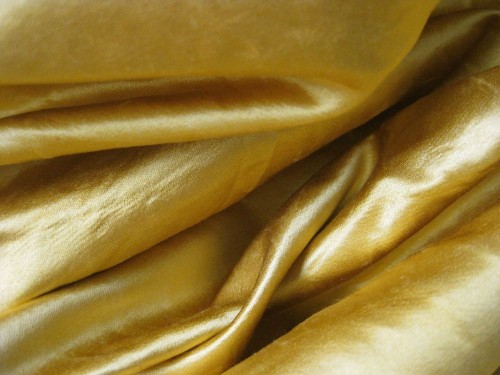
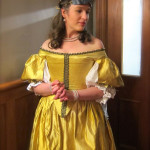
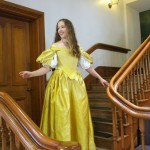
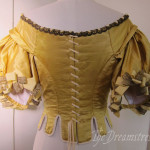

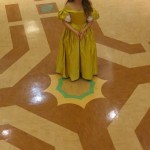
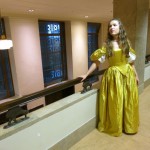
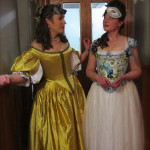
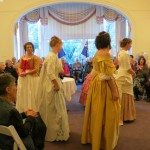
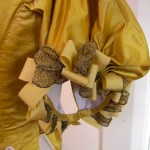
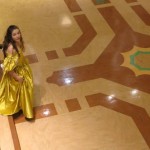
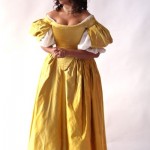
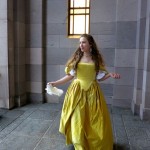
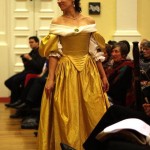
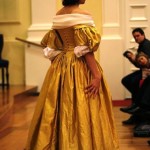
Hi, my daughter and I are considering making the Red and White Queen costumes from Tim Burton’s Alice in Wonderland for a convention. May we raid your designs and techniques for making the bodices? On close inspection of numerous publicity photos of Anne Hathaway and Helena Bonham-Carter, it appears that a mid-17th century silhouette was the inspiration for both costumes. BTW, your original “dorky” bodice point seems to be what was used in both costumes. And, since I am a Paralegal by profession, I must ask if we will be violating any copyright, trademark, or other intelectual property if we use your patterns?
Thank you, Erika.
Hi Erika,
I put my dress diaries online so that other seamstresses can use them as a resource, so I’m happy for you to use anything that is there as a reference. In any case, none of it would be a copyright violation. There is very little protection for garments/fashion design. That’s why cheaper stores can knock off designer garments almost exactly – the copyright violation is in replicating the logos of designer garments.
Hi
You and your gown are lovely!
I have a question. I am considering this Era of gown. I have a concern of how it sits on the shoulders. I have had a frozen shoulder and since it does get fatigued after a day at work I am wondering how the fitting of the shoulder area would effect, if at all, that area.
Did you notice any pressure areas after a few hours of wear? I get “bodice back” when I havnt been to Ren Faire for a year. I’m in my costume for several hours
I have worn this dress for up to 7 hours at a time, and have not noticed any discomfort and pressure in the shoulders – which I do in Regency & some 18th century.
Thank you so much for responding. I just bought some beautiful silk green taffeta curtains from Craigslist. I think I’ve found my inspiration. I’ve considered a Mantua but I like this style so much more for its femininity.
I love everything you sew! This dress reminds me of “The Man In The Iron Mask.” Would you know what pattern I could use to make this look? I’m unable to draft my own. I want something like this with large puffed and splashed sleeves!
Thank you! I used three main sources to drape and bone the under-bodice for my 1660’s gown: the patterns for the 1660’s bodice in a downloadable book on 17th fashion (in German, which I don’t read, but ‘pattern’ is a universal language!), Janet Arnold’s 1660 bodice pattern, and the under-bodice pattern in Corsets and Crinolines. If you scroll down to the bottom of this page and read through each blog post you can see how I made it 🙂